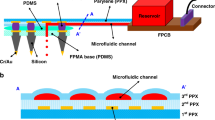Abstract
In this paper, a silicon-based neural probe with microfluidic channels was developed and evaluated. The probe can deliver chemicals or drugs to the target neurons while simultaneously recording the electrical action of these neurons extracellularly. The probe was fabricated by double-sided deep reactive ion etching (DRIE) from a silicon-on-insulator (SOI) wafer. The fluidic channels were formed with V-shape groove etching on the silicon probe and sealed with silicon nitride and parylene-C. The shank of the probe is 4 mm long and 120 μm wide. The thickness of the probe is 100 μm. The probe has two fluidic channels and two recording sites. The microfluidic channels can withstand a pressure drop as much as 30 kPa and the flow resistivity of the microfluidic channel is 0.13 μL min-1 kPa-1. The typical impedance of the neural electrode is 32.3 kΩ at 1 kHz at room temperature.
Similar content being viewed by others
References
Wise K D. Silicon microsystems for neuroscience and neural prostheses. IEEE Eng Med Biol, 2005, 24: 22–29
Vetter R J, Williams J C, Hetke J F, et al. Chronic neural recording using silicon-substrate microelectrode arrays implanted in cerebral cortex. IEEE T Bio-Med Eng, 2004, 51: 896–904
Lee K, Massia S, He J P, Biocompatible benzocyclobutene-based intracortical neural implant with surface modification. J Micromech Microeng, 2005, 15: 2149–2155
Lee K K, He J P, Singh A, et al. Polyimide-based intracortical neural implant with improved structural stiffness. J Micromech Microeng, 2004, 14: 32–37
Pei W H, Zhu L, Wang S J, et al. Multi-channel micro neural probe fabricated with SOI. Sci China Ser E-Tech Sci, 2009, 52: 1187–1190
Bai Q, Wise K D, Anderson D J. A high-yield microassembly structure for three-dimensional microelectrode arrays. IEEE T Bio-Med Eng, 2000, 47: 281–289
Voskerician G, Matthew S S, Rebecca S S, et al. Biocompatibility and befouling of MEMS drug delivery devices. Biomater, 2003, 24: 1959–1967
Ji J, Wise K D. Implantable CMOS circuit interface for multiplexed microelectrode recording arrays. IEEE J Solid-St Circ, 1992, 27: 433–443
Li Y, Baek K, Gulari M, et al. A drug-delivery probe with an in-line flowmeter based on trench refill and chemical mechanical polishing techniques. In: IEEE Sensors Conf, 2007. 1144–1147
Kobayashi R, Kanno S, Lee S, et al. Development of double-sided Si neural probe with microfluidic channels using wafer direct bonding technique. In: Proceedings of the 4th International IEEE EMBS Conference on Neural Engineering, 2009. 96–99
Suzuki T, Ziegler D, Mabuchi K, et al. Flexible neural probes with micro-fluidic channels for stable interface with the nervous system. In: Proceedings of the 26th Annual International Conference of the IEEE EMBS, 2004. 4057–4058
Chen J K, Wise K D, Hetke J F, et al. A multichannel neural probe for selective chemical delivery at the cellular level. IEEE T Bio-Med Eng, 1997, 44: 760–769
Cheung K C, Djupsund K, Yang D, et al. Implantable multichannel electrode array based on SOI technology. J Microelectromech S, 2003, 12: 179–184
Ziegler D, Suzuki T, Takeuchi S. Fabrication of flexible neural probes with built-in microfluidic channels by thermal bonding of parylene. J Microelectromech S, 2006, 15: 1477–1482
Krause G, Lehmann S, Lehmann M, et al. Measurement of electrical activity of long-term mammalian neuronal networks on semiconductor neurosensor chips and comparison with conventional microelectrode arrays. Biosems Bioelectron, 2006, 21: 1272–1282
Tokoro K, Uchikawa D, Shikida M, et al. Comparison of anisotropic etching properties between KOH and TMAH solutions. In: Twelfth IEEE International Conference on Micro Electro Mechanical Systems, 1999, 4: 312–320
Takeuchi S, Ziegler D, Yoshida Y, et al. Parylene flexible neural probes integrated with microfluidic channels. Lab Chip, 2005, 5: 519–523
Westedt U, Wittmar M, Hellwig M, et al. Paclitaxel releasing films consisting of poly (vinyl alcohol)-graft-poly (lactide-co-glycolide) and their potential as biodegradable stent coatings. J Control Release, 2006, 111: 235–246
Author information
Authors and Affiliations
Corresponding author
Rights and permissions
About this article
Cite this article
Guo, K., Pei, W., Li, X. et al. Fabrication and characterization of implantable silicon neural probe with microfluidic channels. Sci. China Technol. Sci. 55, 1–5 (2012). https://doi.org/10.1007/s11431-011-4569-8
Received:
Accepted:
Published:
Issue Date:
DOI: https://doi.org/10.1007/s11431-011-4569-8




